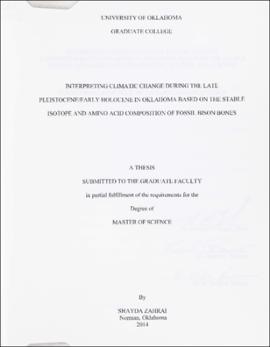| dc.contributor.author | Zahrai, Shayda Katherine | |
| dc.coverage.spatial | Oklahoma | |
| dc.coverage.spatial | Oklahoma | |
| dc.date.accessioned | 2020-10-26T17:00:20Z | |
| dc.date.available | 2020-10-26T17:00:20Z | |
| dc.date.created | 2014 | |
| dc.identifier.uri | https://hdl.handle.net/11244/325628 | |
| dc.description | M.S.University of Oklahoma 2014 | |
| dc.description | Includes bibliographical references (leaves 62-66). | |
| dc.description.abstract | The stable isotope values from both the orgamc (collagen, δ13C, δ15N) and inorganic (hydroxyapatite, δ13C, δ18O) components within fossil bison bones and teeth were used to determine climatic shifts in Oklahoma during the Late Pleistocene/Early Holocene, especially across a period known as the Younger Dryas (12,800 to 11,500 cal B.P.). Globally, the Younger Dryas is a period of cooler, drier climatic conditions. Fossil bison samples were collected from ten different kill sites within Oklahoma and Texas, ranging in age from 13,350 to 1,700 cal B.P. Modern bison samples were collected from a wildlife preserve in Oklahoma for comparison purposes. Because collagen degrades over time, collagen preservation was assessed by comparing the relative amino acid distributions within fossil samples to a modern collagen sample. The amino acid hydroxyproline is unique to collagen, so its presence in fossil collagen is a strong indicator of preservation. Based on the carbon isotope values, the bison diet consisted of primarily C3 grasses during the Younger Dryas, indicating a cooler climate in Oklahoma at this time. Depleted nitrogen values indicate a humid environment within Oklahoma during the Younger Dryas. Depleted oxygen values also confirm a cooler, wetter environment during this period. | |
| dc.format.extent | xi, 66 leaves | |
| dc.format.medium | xi, 66 leaves : illustrations (some color), map ; 28 cm | |
| dc.language.iso | eng | |
| dc.subject.lcsh | Climatic changes--Oklahoma | |
| dc.subject.lcsh | Bison, Fossil--Oklahoma | |
| dc.subject.lcsh | Geology, Stratigraphic--Pleistocene | |
| dc.subject.lcsh | Geology, Stratigraphic--Holocene | |
| dc.title | Interpreting climatic change during the Late Pleistocene/Early Holocene in Oklahoma based on the stable isotope and amino acid composition of fossil bison bones | |
| dc.type | Text | |
| dc.contributor.committeeMember | Elmore, R. Douglas | |
| dc.contributor.committeeMember | Bement, Leland C. | |
| dc.contributor.committeeMember | Engel, Michael H. | |
